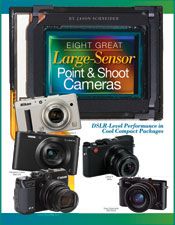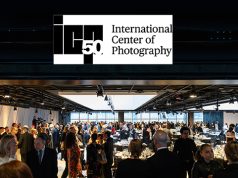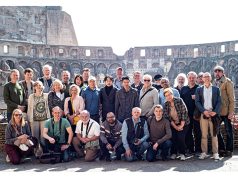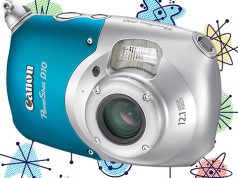
The concept of a compact, high-performance camera without interchangeable lenses has been around for eons—the landmark full-frame (24x36mm) 35mm Leica A of 1925 is a stellar example. However, in the digital era, point-and-shoot cameras have been defined, until fairly recently, by two distinct features—non-interchangeable lenses and small sensor sizes.
Small sensors in the 1/2.5- to less than 1/1.7-inch (7–9.5mm diagonal) range make it easier for manufacturers to design more compact cameras with longer zoom ranges and enhanced depth of field. And the incredible advances in sensor and imaging processing technology have allowed small-sensor P&S cameras to deliver impressive image quality, versatility and user satisfaction.
Rise of the Large-Sensor P&S
Perhaps that’s why it took until 2008 for first large-sensor digital point-and-shoot model, the original Sigma DP1, to reach the market. Incorporating a slightly smaller than APS-C-size version of Sigma’s proprietary three-layer Foveon X3 sensor and fitted with a high-quality 28mm-equivalent f/4 lens, the compact, minimalist DP1 created a sensation among enthusiasts. It established a loyal cult following and set the stage for Sigma’s current APS-C-format Foveon X3-sensor DSLRs.
The DP1 also made camera manufacturers sit up and take notice of a previously untapped segment of the market. This committed, knowledgeable and profitable customer base consists of serious enthusiasts and pros looking for a cool, high-quality, high-performance, walk-around compact that’s capable of delivering image quality on a par with their DSLRs.
The rest, as they say, is history, and reading about the “Eight Great Large-Sensor Point & Shoot Cameras” we’ve detailed here will give you a good idea of how far we’ve come since 2008—and also what makes these cameras so appealing to the connoisseurs among your customers.
Big-Sensor Advantages: Image Quality and More
For any given megapixel rating, the larger the sensor, the bigger the individual pixels will be—and sensors with larger pixels deliver a number of significant image quality advantages. These include better performance and less noise at high ISOs (especially at ISO 1600 and above), enhanced dynamic range (the ability to accurately capture and output extreme highlights and shadows), a wider color gamut, better color differentiation within a given hue, and increased color saturation, especially at high ISOs.
In addition, larger sensors require lenses with proportionally longer focal lengths to cover any given angle due to their lower crop factors—only 1.5 for an APS-C-format camera versus 4.5–6.0 for a typical point and shoot. As a result, a 50mm normal lens on a full-frame camera covers the same angle as a 33mm lens on an APS-C-format camera, and a lens of only 11mm on a 1/1.7-inch-format P&S.
Since longer lenses provide shallower depth of field at any given aperture, large-sensor cameras with fast lenses in the f/1.8 to f/2.8 range enable users to create striking pictorial effects and make portrait subjects “pop” by using limited depth of field and bokeh creatively—a sophisticated technique once largely restricted to DSLRs and other interchangeable-lens cameras.
It’s also worth noting that large-sensor P&Ss are almost always high-end enthusiast models that not only sport fast, high-performance lenses but also a full complement of advanced features, including RAW capture, auto HDR, noise reduction, Full HD 1080p video capture, state-of-the-art AF systems and fast full-res burst rates, along with impressive responsiveness and minimal shutter lag times.
When Sony first announced the Cyber-shot DSC-RX1 with a full-frame 24.3 megapixel sensor and a non-interchangeable Carl Zeiss Sonnar T* 35mm f/2.0 lens at a price just shy of $2,800, I marveled at their chutzpah. But it’s now firmly established as a cult classic, and Sony can’t make them fast enough to keep up with demand! (In fact, they just released an upgraded RX1R version.)
Indeed, perhaps that’s the secret of the success of this entire category: each one of the cameras on our Eight Great list offers a distinctive personality, authenticity and style, along with genuine performance creds. In an era of mass-market commoditization, that’s something manufacturers and dealers, as well as hip photographers that demand the best, can take to the bank.
Eight Great Large-Sensor P&S Cameras at a Glance
Nikon Coolpix A. A fine example of traditional, understated styling in a contemporary vein, this sleek compact features a 16.2 megapixel DX-format (APS-C) CMOS sensor and a 7-element, 5-group, 28mm-equivalent f/2.8 Nikkor lens with a 7-blade diaphragm for beautiful bokeh. The optical low-pass filter has been eliminated to enhance resolution, and the camera provides such enthusiast-aimed features as RAW capture, a 3.0-inch, 921k-dot LCD, a 4-frames-per-sec full-res burst rate and manual focusing via a classic control ring. Other key features include: Full HD 1080p video recording with stereo sound; auto and manual exposure bracketing; a full-size accessory shoe; and Wi-Fi via an optional WU-1a mobile adapter. $1,099.95. nikonusa.com
Sigma DP2 Merrill. The latest normal-lens iteration in Sigma’s landmark compact DP line boasts a fixed 45mm-equivalent f/2.8 lens that includes “F” low-dispersion FLD glass for superior aberration correction and a 9-blade diaphragm for smooth rendition of out-of-focus areas. An APS-C-format, 46MP Foveon X3 sensor captures all primary RGB colors at each pixel location in three layers to provide full color data at each pixel point. Other key features include: a high-res 3.0-inch, 920k-dot LCD; RAW + JPEG capture; and a Dual True II image-processing engine. It comes with Sigma Photo Pro image-processing software as a free download. $999. sigmaphoto.com
Panasonic Lumix DMC-LF1.The premium DMC-LF1—part of the new LF series, the LX series’ sister line—boasts a 1/1.7-inch, 12.1MP High Sensitivity MOS sensor that’s larger than standard compacts’, to produce high-res images with striking clarity. The extensive light receiving area of each cell delivers crisp high-sensitivity images in lower light, even at ISO 12,800, with a notable S/N ratio and wide dynamic range. The pocketable camera employs a 7.1x optical zoom, 28–200mm equivalent f/2.0 Leica DC Vario-Summicron lens and a first-in-its-class adjustable, eye-level 0.2-inch 200k-dot electronic viewfinder with 100% field of view. With Wi-Fi and NFC technology, the LF1’s “touch & share” lets users connect it to a smartphone with one touch of the devices for immediate sharing or to use the phone as a remote shutter. Other key features include: a 3.0-inch, 920k-dot LCD; Full HD video recording with zoom, OIS and filter effects; RAW shooting; iA plus to adjust the defocused background area, exposure compensation and white balance; an exposure control ring; and a composition guide. $499. panasonic.com
Canon PowerShot G1 X. The latest large-format offering in Canon’s long running enthusiast/pro-aimed G series, this robust, rugged-looking machine has a 14.3MP, 1.5-inch (measured diagonally) CMOS sensor that’s nearly equal in size to the APS-C format. One of the few cameras in its class with an optical zoom viewfinder, in addition to a high-res 3.0-inch, 922k-dot vari-angle LCD, it also provides 14-bit RAW + JPEG capture, has a hybrid image stabilizer and a wide-angle 4x, 28–112mm equivalent f/2.8–5.8 zoom lens that incorporates ultra-high-refractive index glass. Other key features include: Canon’s HS system for ISOs to 12,800; HDR scene mode; Full HD 1080p video recording at 24 fps via a dedicated movie button; an electronic level; a wide range of manual and automatic shooting modes; and a slew of built-in creative effects. $699.99. usa.canon.com
Ricoh GR. This ingeniously slim, high-performance compact has a 16.2MP APS-C-format CMOS sensor and a GR Engine V image processor designed to deliver high resolution along with impressively fast response times. The low-pass filter has been eliminated to enhance resolution and detail. Its fast 28mm-equivalent f/2.8–16 lens facilitates low-light shooting and the creative use of shallow depth of field, plus complements its wide ISO 100–25,600 sensitivity range. A high-res 3.0-inch, 1,230k-dot LCD provides crisp, detailed viewing and playback, and the camera supports RAW + JPEG formats. There’s even a choice of two optional optical finders that slide into its hot shoe. Other key features include: Full HD 1080p video capture; macro mode; image effects, including retro and cross-processing; a full range of manual controls and auto modes, such as face detection; a maximum full-res 4-fps burst rate; a dual-axis electronic level; and Eye-Fi wireless card compatibility. $799.95. us.ricoh-imaging.com
Leica X Vario. Billed as the first APS-C-format compact with a zoom lens, this elegant, high-end aluminum- and magnesium-bodied camera delivers pro-caliber imaging performance thanks to its impressive 16.2MP CMOS sensor and acclaimed Leica Vario-Elmar Asph 28–70mm equivalent f/3.5–6.4 lens. Other premier features include a high-res 3.0-inch, 920k-dot LCD, a dedicated socket for an optional eye-level EVF that provides a DSLR-like viewing and shooting experience, and RAW (DNG) + JPEG capture. The X Vario also provides: a maximum full-res 5-fps burst rate; an ISO 100–12,500 sensitivity range; Full HD 1080p video recording at 30 fps; a classic manual focusing ring plus manual exposure control; a wind cut filter for audio clarity; and, of course, that indefinable Leica panache. $2,850. us.leica-camera.com
Fujifilm X100S. With a retro look reminiscent of a classic rangefinder camera, a unique 16.3MP APS-C-format X-Trans CMOS II sensor designed with a randomized pixel pattern to reduce moiré patterns and aliasing without requiring a low-pass filter, and a fast, sharp 35mm-equivalent f/2 lens, the X100S combines high style with high tech. It also offers: a 2.8-inch, 460k-dot LCD; an innovative optical and electronic hybrid viewfinder that lets users choose between OVF and EVF viewing; intelligent hybrid AF employing both contrast- and phase-detection methods for improved speed and performance; RAW capture with in-camera conversion and file processing; ISO 100–25,600; Full HD 1080p video recording at 60 fps; film simulation and creative filters; plus a robust die-cast magnesium body. $1,299.95. fujifilmusa.com
Sony Cyber-shot DSC-RX1R. The world’s first and only full-frame (35mm format) non-interchangeable-lens compact, Sony’s beautifully made, high-performance new flagship P&S sports a high-res 24.3MP Exmor CMOS sensor without a low-pass filter to deliver maximum resolution. Its fast, sharp 35mm f/2.0 Carl Zeiss Vario-Sonnar T* wide-angle lens incorporates three aspheric elements to minimize chromatic aberrations. Other high-end features in this special edition of the RX1 include: a high-res 3.0-inch, 1,229k-dot Xtra Fine LCD; ISO settings from 100–25,600; a Bionz image processor that provides 14-bit RAW image data; a 5-fps full-res burst rate; high-speed AF; auto HDR; Full HD 1080p video capture at 60p, 60i and 24p framing rates in AVCHD 2.0 codec; Optical SteadyShot image stabilization; noise reduction mode; MF focus-peaking indication; and included RAW Image Development PC software. $2,799.99. sony.com





